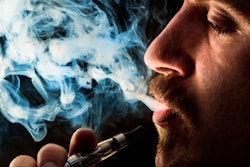
A recent study published online on August 11 in the Journal of Adolescent Health found that vaping is linked to a substantially increased risk of COVID-19 among teenagers and young adults. The study, led by researchers at Stanford University, showed that young people who vaped were five times more likely to be diagnosed with COVID-19 than those who did not vape.
 Tom Viola, RPh.
Tom Viola, RPh.Online surveys were completed by 4,351 participants, ages 13 to 24, who lived in the U.S. Participants answered questions about whether they had ever vaped or vaped and also smoked tobacco cigarettes, as well as whether they had vaped or both vaped and smoked in the past 30 days. Lead author Shivani Mathur Gaiha, PhD, and colleagues recruited a sample of e-cigarette users (50.2%) and nonusers (49.8%) who fell into the following categories: adolescents (ages 13-17; 33.7%), young adults (ages 18-20; 41.6%), and adults (ages 21-24; 24.7%).
The participants also answered questions about whether they had experienced COVID-19 symptoms, if they had been tested, and if they had received a positive test result for COVID-19. Young people who vaped within the previous 30 days often experienced COVID-19-like symptoms, such as coughing, fever, and difficulty breathing, and, thus, were more likely to receive COVID-19 testing.
The researchers found that COVID-19 diagnosis was five times more likely among participants who consistently vaped, seven times more likely among participants who consistently vaped and also smoked, and 6.8 times more likely among participants who vaped and also smoked within the past 30 days. In addition, COVID-19 testing was 2.6 times more likely among participants who vaped in the past 30 days and nine times more likely among participants who had vaped and also smoked in the past 30 days.
Interestingly, smoking tobacco cigarettes was only associated with COVID-19 testing, while vaping and vaping and also smoking, whether consistently or within the past 30 days, were associated with both COVID-19 testing and a positive diagnosis.
The researchers did adjust their sample to be representative of the U.S. population and included confounders, such as age, sex, LGBTQ status, race, and ethnicity, as well as regional trends in the use of vaping devices. The study was also adjusted for obesity, which was found as an underlying risk factor among 13- to 24-year-olds.
However, the researchers did not ask participants about hospitalization or the severity of symptoms. Thus, they could not ascertain which participants were infected with the novel coronavirus but asymptomatic.
The findings show that among adolescents and young adults, vaping as well as vaping and also smoking "are significant underlying risk factors for COVID-19 that [have] previously not been shown," the group concluded.
Tom Viola, RPh, is a clinical educator, professional speaker, and published author in the areas of oral pharmacology and local anesthesia. For more information on this and other pharmacology topics, as well as a list of dates and locations where you can attend his latest seminars, visit his website at www.tomviola.com.
The comments and observations expressed herein do not necessarily reflect the opinions of DrBicuspid.com, nor should they be construed as an endorsement or admonishment of any particular idea, vendor, or organization.



















